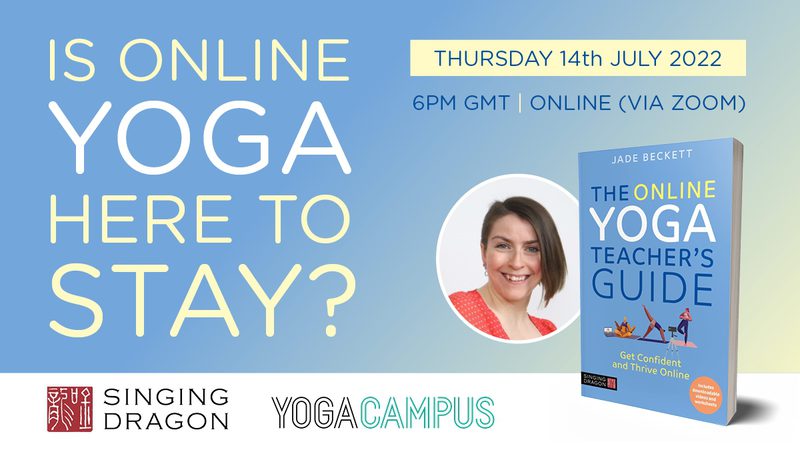Written by Jade Beckett
Rewind to March 2020 and it’s fair to say we all thought teaching yoga online was a temporary thing. It was passable to have a thrown together space with the sofa as the backdrop, sit your laptop on a pile of blocks on a chair, not have a microphone, get interrupted by your cat during class… here in Summer 2022 that really isn’t the case anymore.
Online yoga has had a heck of a glow up over the past two years and is constantly evolving. The landscape for yoga teachers has changed forever, with this sector of the industry predicted to boom even further by 2027. Yet again, it is time for us to step up our game so we can keep developing top-tier online offerings that are slick, student-friendly and deliver expert transformation to our students and we’re ready to capitalise on that growth.

You might have noticed the demands within your existing student base evolving – you’ve got students who love being online and you’re struggling to get them to come back to in-person classes, you’re being asked for recordings of classes and other ways to practice online or you might have students who you’ve never spoken to learning from you online!
There are also a lot of benefits to teaching online for you as a teacher that aren’t to be sniffed at; you can work when suits, no venue hire costs, no travel time, no capacity limitations, the option to teach people without the restrictions of location or time zone.
It’s really clear that online yoga is absolutely here to stay and we need to be strategic and considered in our approach. Setting up a weekly zoom class and posting about it occasionally isn’t going to cut the mustard in the evolving online yoga space.
The big players like Peloton have seen this opportunity too – starting to offer online classes to members, like a lot of other yoga brands such as Alo Yoga and Glo. These larger companies have been perfectly placed to take a piece of the online yoga pie because they can invest a lot of resources into their customer experience and journey, technology and systems, marketing and PR. A lot of the time they’re able to offer a scale of economy – because of their spend, they attract a large number of customers, and can offer an incredibly low price point because of that.
Of course, we can’t compete with that level of resource in terms of money and people power as independent teachers and studios. What we do have is so much more – our dedicated expertise, our unique voice and a set of people who deeply connect with what we do. And that’s something that these corporations don’t have. They’re collectives, we’re individuals and that is a huge point of difference.
How do we integrate our online offerings into something that is more strategic, totally authentic and aligned with everything else we do?
It’s about getting to understand what your uniqueness is, how that appeals to your ideal customer, getting to know who they are, then designing an offering that meets their needs and sharing valuable content around that frequently.
Even if every yoga teacher taught the same ten poses, each experience would be totally different. Every teacher has their own unique vibe, flair for description, point of focus for that sequence and intention and that is where the magic is.
The bit that requires a bit more skill, time and thought is nailing down what that uniqueness actually is, and developing the ability to articulate that uniqueness in a way that people will understand and connect with on a deeper level.
Teachers often struggle with their ideal student group. A common thing I hear is “I want everyone to come to my class”. The problem is that when you’re so general people don’t actually hear you because you’re not talking to them… so you end up with no one committing. It’s far more successful to understand what your uniqueness is and how that appeals to people and then talk directly to those people.
Another issue is getting hung up on an Ideal Client Avatar – these detailed, story-like profiles are so in-depth that the person described doesn’t actually exist and the teacher ends up missing students they could really help. These also tend to attract identical people. You end up with a space of clones that don’t reflect the diversity of the world we live in. Have you ever been to one of those studios filled with thin, able-bodied women, with very expensive mats and leggings? This is how that happens!
It’s about being specific… but not too specific. If you’re great at teaching unusual classes your ideal student group might be businesses looking to boost the creativity of their managers. If you’re fantastic at being encouraging and supportive, you might look to teach nervous beginners, for example.
Then you develop a suite of online offerings specifically for those people. This could be a Zoom class with a specially designed structure, an on-demand membership with 1:1 catch-up or group calls, a course or something else like an e-book. Bear in mind things like how tech-savvy those students are, what their time availability is like and what formats they like to consume in. You can do one, two or a mix of those things to appeal to different people within your ideal customer group.
A great place to start with gathering this information and developing your strategy is to ask your students or people you’ve taught already. Ask what they like about your teaching, what their needs are and use that information to develop your online offerings.
These people already know you, like and trust you so they’re more likely to buy from you than someone who is cold stumbling across you on Google or Instagram for the first time. Most of your online students are likely to come from this pot of people, at least initially.
Taking the time and effort to listen, connect and build relationships with people is the absolute best way to grow. It’s never “here’s my Zoom class, book” on the odd occasion when you remember, instead it’s you always saying “here’s useful information, here’s the transformation I can help you with and why” – that helps people build a connection, trust you and go on to buy from you.
The Online Yoga Teacher’s Guide: Get Confident and Thrive Online is available to pre-order now.
Join us on Thursday 14 July from 18:00 to 19:00 UK time: In this free talk open to all in our community, Jade Beckett will discuss the state of the online yoga space and whether it is really here to stay, opportunities for growth, upcoming trends in online teaching and how teachers can make online yoga a permanent part of their business for the future.
